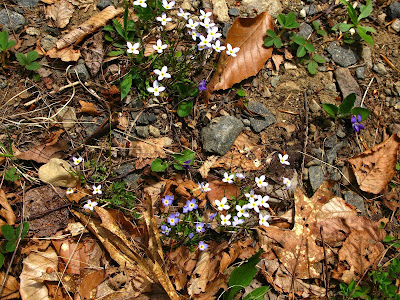
Shadblow in bloom in the Palmertown Mountains
The forecast was for wind and rain this afternoon (oh please please please let it be so, we are so dry), but the morning dawned cool and sunny. Quick, I said to my husband, let's hike to the Hudson overlook while the Shadblow are still in bloom and before a rainstorm brings the blossoms down. There's a gently sloping open woods up there in the Palmertown Mountains, where there are so many Shadblow trees it almost looks like an orchard.
So off we went and up, up, up, stopping along the way to catch our breath and admire the beauty all around us. The trail was strewn with flowers like a bridal path: Bluets by the thousands, violets of several kinds, and even some newly opened strawberry blossoms. The most prevalent violet today was the Ovate-leaved (Viola fimbriatula), a deep, deep purple flower with fuzzy stems. And oval-shaped leaves. Tiny brand-new plants of this violet mingled with the myriad Bluets along the trail.

The trail was strewn with Bluets and Ovate-leaved Violets
Long-spurred Violets (Viola rostrata) are pale with a deep-colored center. And a long spur.

Sessile-leaved Bellwort (Uvularia sessilifolia) has leaves that clasp the stem.
While we were up on the mountain the clouds rolled in, the wind came fast behind them, and drops of rain began to fall. We hurried down expecting to get drenched. But we only got a sprinkle. Darn! I can't remember a spring as dry as this.

















































